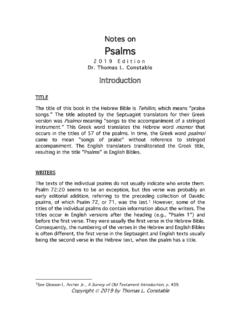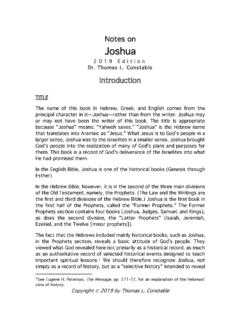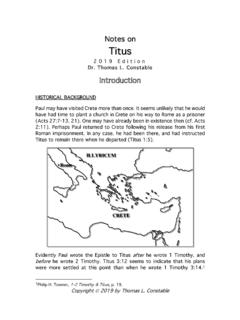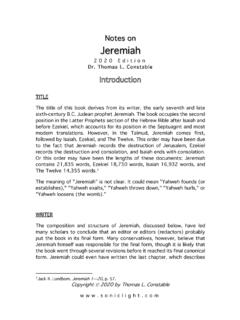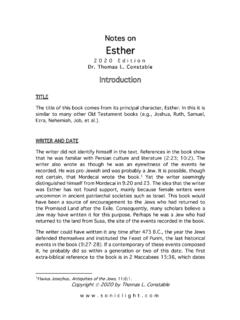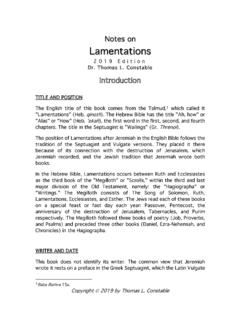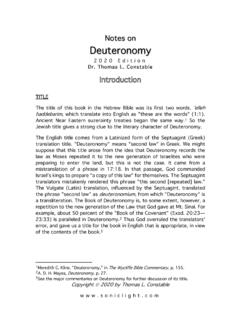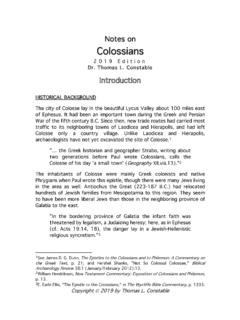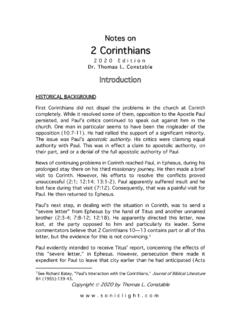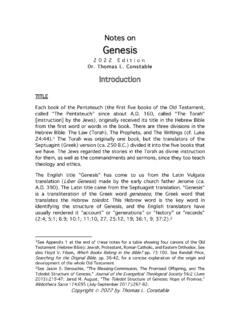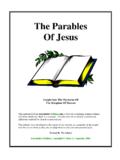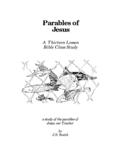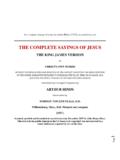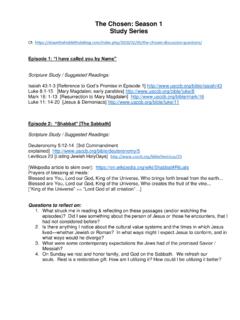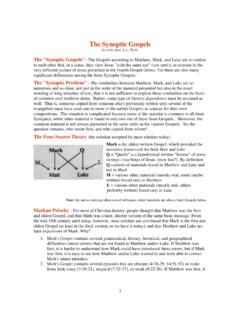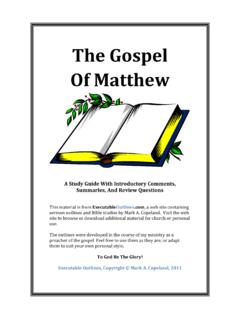Transcription of Notes on John - Plano Bible Chapel
1 Copyright 2022 by Thomas L. Constable Notes on John 2022 Edition Dr. Thomas L. Constable WRITER The writer of this Gospel did not identify himself as such in the text. This is true of all the Gospel evangelists. Nevertheless there is evidence within this Gospel, as well as in the writings of the church fathers, that the writer was the Apostle The internal evidence from the Gospel itself is as follows: In 21:24, the writer of "these things" ( , the whole Gospel) was the same person as the "disciple whom jesus loved" (21:7).
2 2 That disciple was one of the seven disciples mentioned in 21:2. He was also the disciple who sat beside jesus in the upper room when He instituted the Lord's Supper and the disciple to whom Peter motioned (13:23-24). This means that he was one of the Twelve, since only they were present in the upper room (Mark 14:17; Luke 22:14). The "disciple whom jesus loved" was also one of the inner circle of three disciples, namely, Peter, James, and John (Mark 5:37-38; 9:2-3; 14:33; John 20:2-10). James died in the early history of the church, probably in the early 40s (Acts 12:2).
3 There is good evidence that whoever wrote this Gospel did so after then. The writer was also not Peter (21:20-24). This evidence points to John as the "disciple whom jesus loved," who was also the writer of this Gospel. The writer claimed to have seen jesus ' glory (1:14; cf. 1:1-4), which John did at the Transfiguration. There are several Johns in the New Testament. This John was one of Zebedee's sons, who was a fisherman before jesus called him to leave his nets and follow Him. igw1 See Marcus Dods, "The Gospel According to John," in The Expositor's Greek Testament, 1:655-78; W.
4 Graham Scroggie, A Guide to the Gospels, pp. 135-38. 2 Quotations from the English Bible in these Notes are from the New American Standard Bible (NASB), 2020 edition, unless otherwise indicated. 2 Dr. Constable's Notes on John 2022 Edition "To a certain extent each of the Gospels reflects the personality of its author, but in none of them is there a more distinctive individuality manifested than in John."1 In the article just quoted, the writer showed how John projected his personality into his writing of this Gospel.
5 The external evidence also points to the Johannine authorship of the fourth Gospel. Irenaeus, the bishop of Lyons (ca. 130-200), wrote that he had heard Polycarp (ca. 69-155), who was a disciple of John. It was apparently from Polycarp that Irenaeus learned that, "John, the disciple of the Lord, who also had leaned upon His breast, had himself published a Gospel during his residence in Ephesus in Asia."2 Other later church fathers supported this tradition, including Theophilus of Antioch (ca.)
6 180), Clement of Alexandria, Tertullian of Carthage, and Eusebius (fourth century) also specifically mentioned that Matthew and John, among the apostles, wrote the Gospels that bear their Some scholars have rejected this seemingly clear evidence and have refused to accept Johannine authorship. This criticism generally comes from those who hold a lower view of Scripture. Answering their objections lies outside the purpose of these PLACE OF WRITING Eusebius also wrote that John ministered to the church in Ephesus, which Paul had founded (Acts 19:1-20), for many The Isle of Patmos, where John spent some time in exile, is close to Ephesus (cf.
7 Rev. 1:9-11). 1 Merrill C. Tenney, "The Author's Testimony to Himself," Bibliotheca Sacra 120:479 (July-September 1963):223. 2 Irenaeus, Against Heresies, 3:1. 3 See Edwin A. Blum, "John," in The Bible Knowledge Commentary: New Testament, p. 267; Merrill C. Tenney, "John," in John-Acts, vol. 9 of The Expositor's Bible Commentary, pp. 5-6; and George R. Beasley-Murray, John, pp. lxvi-lxxv. 4 Eusebius, The Ecclesiastical History of Eusebius Pamphilus, 3:24:3-8. 5 For treatment of these views, see Donald A. Carson, The Gospel According to John, pp.
8 68-81, and books on Bible Introduction. For a more complete discussion of authorship, see B. F. Westcott, The Gospel According to St. John: The Authorised Version with Introduction and Notes , pp. v-xxxv. 6 Eusebius, 3:24:1. 2022 Edition Dr. Constable's Notes on John 3 Eusebius wrote that John composed his Gospel when he was at During the first century, that city was one of the largest centers of Christian activity in the Gentile world. Antioch of Syria and Alexandria in Egypt have been suggested as sites of composition, but they do not have as good support as Ephesus DATE A few scholars believe that John could have written this book as early as 45, the date when Saul of Tarsus' persecutions drove many Christians out of Jerusalem (cf.)
9 Acts 8:1-4).3 There are two main problems with such an early date: First, John seems to have assumed that the Synoptic Gospels were available to the Christian public. There is some doubt about this, since it assumes an assumption, but most scholars believe, on the basis of content, that John selected his material to supplement the material in the This would put the fourth Gospel later than the Synoptics. Second, according to early church tradition the Apostle John lived long in the first century.
10 This would make a later date possible even though it does not prove a later date. Some students of the book believe that John 21:18-22 implies that Peter would die before John did, and Peter died about 67. In general, most authorities reject a date this early for these and other reasons. Some conservatives date the Gospel slightly before 70, because John described the land of Israel and Jerusalem as they were before the Roman destruction (cf. 5:2).5 This may be a weak argument, since John frequently used the Greek present tense to describe things in the past.
